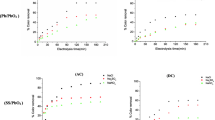Abstract
The application of slurry electrolysis for high-arsenic antimony–gold concentrate treatment provides several benefits, including a short treatment process, complete separation of antimony and gold, and low environmental impact. A key process in slurry electrolysis is the anodic reaction. In this study, pure stibnite was used as raw material and linear sweep voltammetry was adopted to investigate the anodic process with the introduction of the Fe(III)/Fe(II) redox couple. The results indicated that the anodic polarization curve comprised three distinct regions: a low potential region (0.47–0.65 V), where the reaction rate was controlled by the electrochemical reaction; a medium potential region (0.65–0.90 V), where the electrochemical reaction was accelerated with an increase in overpotential, and the diffusion of Fe(II) gradually became the rate-controlling step; and a high potential region, where the reaction reached a stable state in which Fe(II) diffusion controlled the rate, and the polarization current density changed minimally with an increase in potential. The effects of particle size, liquid–solid ratio, stirring speed, temperature, and iron ion concentration were also investigated. The introduction of Fe(III)/Fe(II) considerably improved the oxidative leaching rate and significantly reduced the power consumption of electrolysis, offering the possibility of using slurry electrolysis in industrial applications.











Similar content being viewed by others
References
T. Zhao, Antimony (Metallurgical Industry Press, Beijing, 1987), pp. 7–10, 106.
C.G. Anderson, Chem. Erde-Geochem. 72, 3. https://doi.org/10.1016/j.chemer.2012.04.001 (2012).
S.A. Awe, and Å. Sandström, Hydrometallurgy 137, 60. https://doi.org/10.1016/j.hydromet.2013.04.006 (2013).
R.S. Multani, T. Feldmann, and G.P. Demopoulos, Hydrometallurgy 164, 141. https://doi.org/10.1016/j.hydromet.2016.06.014 (2016).
X. Hu, M. He, S. Li, and X. Guo, J. Geochem. Explor. 176, 76. https://doi.org/10.1016/j.gexplo.2016.01.009 (2017).
Z. Ouyang, S. Liu, C. Tang, Y. Chen, and L. Ye, Vacuum 159, 358. https://doi.org/10.1016/j.vacuum.2018.10.062 (2019).
S. Dembele, A. Akcil, and S. Panda, Miner. Eng. 175, 107304. https://doi.org/10.1016/j.mineng.2021.107304 (2022).
Z. Zhou, D. Liu, H. Xiong, B. Zhang, B. Yang, Y. Deng, and J. Zhao, Vacuum 157, 487. https://doi.org/10.1016/j.vacuum.2018.08.022 (2018).
C. Wang, S. Shao, B. Ma, X. Li, Y. Cheng, and P. Xing, Nonferrous Metals (Extractive Metallurgy). 08, 11. https://doi.org/10.3969/j.issn.1007-7545.2019.08.002 (2019).
S. Aktaş, and B.N. Çetiner, Mining. Metallurgy & Exploration. 37, 1729. https://doi.org/10.1007/s42461-020-00266-x (2020).
S. Ubaldini, F. Vegliò, P. Fornari, and C. Abbruzzese, Hydrometallurgy. 57, 187. https://doi.org/10.1016/S0304-386X(00)00107-9 (2000).
T. Yang, M. Jiang, Q. Lai, J. Chen, and J. Cent, South Univ. T. 12, 290. https://doi.org/10.1007/s11771-005-0147-1 (2005).
J. Yang, and Y. Wu, Hydrometallurgy 143, 68. https://doi.org/10.1016/j.hydromet.2014.01.002 (2014).
Q. Tian, H. Wang, Y. Xin, D. Li, and X. Guo, Hydrometallurgy 159, 126. https://doi.org/10.1016/j.hydromet.2015.11.011 (2016).
P. Guo, S. Wang, and L. Zhang, Hydrometallurgy 190, 105161. https://doi.org/10.1016/j.hydromet.2019.105161 (2019).
O. Celep, Miner. Eng. 172, 107171. https://doi.org/10.1016/j.mineng.2021.107171 (2021).
Z. Dong, Z. Zhou, H. Xiong, B. Yang, and Y. Dai, Sep. Purif. Technol. 279, 119776. https://doi.org/10.1016/j.seppur.2021.119776 (2021).
G. Deschênes, C. Xia, M. Fulton, L.J. Cabri, and J. Price, Miner. Eng. 22, 799. https://doi.org/10.1016/j.mineng.2009.02.003 (2009).
G. Morizot, and P. Ollivier, Miner. Eng. 6, 841. https://doi.org/10.1016/0892-6875(93)90058-U (1993).
T. Yang, S. Rao, W. Liu, D. Zhang, and L. Chen, Hydrometallurgy 169, 571. https://doi.org/10.1016/j.hydromet.2017.03.014 (2017).
G. Larrabure, and J.C.F. Rodríguez-Reyes, Miner. Eng. 173, 107194. https://doi.org/10.1016/j.mineng.2021.107194 (2021).
Y. Hua, Y. Yang, and F. Zhu, J. Mater. Sci. Technol. 19, 619. https://doi.org/10.3321/j.issn:1005-0302.2003.06.030 (2003).
W. Qin, H. Luo, W. Liu, Y. Zheng, K. Yang, J. Han, and J. Cent, South Univ. 22, 868. https://doi.org/10.1007/s11771-015-2595-6 (2015).
Ö. Gök, Hydrometallurgy 149, 23. https://doi.org/10.1016/j.hydromet.2014.06.007 (2014).
M. Zekavat, H. Yoozbashizadeh, and A. Khodaei, JOM-US. 73, 903. https://doi.org/10.1007/s11837-020-04531-8 (2021).
E. Sminčáková, JOM-US. 61, 32. https://doi.org/10.1007/s11837-009-0149-9 (2009).
Y. Li, H. Xue, P. Taskinen, A. Jokilaakso, C. Tang, W. Jin, M. Rämä, Y. Chen, and S. Yang, J. Clean. Prod. 313, 127847. https://doi.org/10.1016/j.jclepro.2021.127847 (2021).
L. Ye, Z. Ouyang, Y. Chen, and Y. Chen, Hydrometallurgy 186, 210. https://doi.org/10.1016/j.hydromet.2019.04.021 (2019).
Y. Zhang, C. Wang, B. Ma, X. Jie, and P. Xing, Hydrometallurgy 186, 284. https://doi.org/10.1016/j.hydromet.2019.04.026 (2019).
D. Qiu, Slurry electrolysis (Metallurgical Industry Press, Beijing, 1999), pp 6–7.
S. Zhang, Y. Li, R. Wang, B. Wang, Z. Xu, S. Chen, and M. Chen, J. Clean. Prod. 152, 1. https://doi.org/10.1016/j.jclepro.2017.03.087 (2017).
D. Qiu, Chin. Eng. Sci. (in Chinese). 1, 67. (1999).
Z. Li, L. He, Z. Zhao, D. Wang, W. Xu, and A.C.S. Sustain, Chem. Eng. 7, 16738. https://doi.org/10.1021/acssuschemeng.9b04127 (2019).
Y. Zhang, D. Qiu, C. Wang, Y. Chen, Z. Yao, X. Jie, W. Gao, and S. Ruan, Chin. J Chem. Eng. 41, 466. https://doi.org/10.1016/j.cjche.2021.12.011 (2022).
Y. Zhang, and J. Chen, Nonferrous Met. 50, 72. (1998).
C. Wang, D. Qiu, and P. Jiang, Nonferrous Met. 55, 25. https://doi.org/10.3969/j.issn.2095-1744.2003.01.008 (2003).
Q. Fu, and R. Man, Guangdong Chem. Ind. 45, 4. https://doi.org/10.3969/j.issn.1007-1865.2018.08.003 (2018).
Funding
This work was supported by the National Key R&D Program of China (Grant No. 2019YFC1908401, 2019YFC1908301), and the National Natural Science Foundation of China (Grant No. 51604030).
Author information
Authors and Affiliations
Corresponding authors
Ethics declarations
Conflict of interest
The authors declare that they have no conflict of interest.
Additional information
Publisher's Note
Springer Nature remains neutral with regard to jurisdictional claims in published maps and institutional affiliations.
Rights and permissions
About this article
Cite this article
Zhang, Y., Yao, Z., Jie, X. et al. Anodic Process of Stibnite in Slurry Electrolysis: Indirect Electro-Oxidation. JOM 75, 1551–1558 (2023). https://doi.org/10.1007/s11837-022-05563-y
Received:
Accepted:
Published:
Issue Date:
DOI: https://doi.org/10.1007/s11837-022-05563-y




